Saker
Mykola Rud'
photo by author;
drawing by R. Sorish;
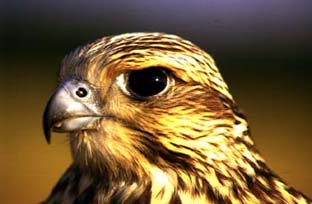
The Saker is a species of the falcon
family, slightly smaller than the Gyrfalcon.
Its maximum size is 60 cm, and it weighs
800-1300 g, with the wingspan of females,
which are significantly larger than males,
reaching 413 mm.
When agitated, the bird imitates the
sound kiak-kiak-keiek-keiek.
The Saker is characteristically reddish or brown-coloured, with a faint ‘moustache’ formed by two dark stripes on either side of the head. After moulting in its second year, its back, wings and upper tail take on a dark-grey hue. Speckled breast and underbelly plumage gives way to broad stripes, while the legs and region above the beak, formerly blue, take on a yellow colouring.
A rather smaller and more contrastingly coloured species, described by some authors as the Lorentso Falcon, is in fact also the Saker. Old Slavonic name of the bird, krasnyj sokil (“krasnyj” meaning “red” or “fair”) reflects not only its warm colouring, but also its excellent qualities as a hunting bird. Another ancient Slavonic name is rarog. Among falconers of Middle Asia, the bird is known as itelgu (itelgy), derived from the root “it” meaning “dog” – the falcon is seen to possess characteristic traits of man’s faithful four-legged friend. Arabs call the bird saker, as it is also known in the English-speaking world.
The German name given to the Saker means literally “strangler falcon”. The injustice, inappropriateness and discourtesy of such a title for the noble bird is self-evident – the Saker, like other true falcons, nimbly and humanely cuts the neck vertebrae of its prey with a specialised indent in its upper beak, quickly stopping needless suffering. It never strangles. In the wild the Saker preys mainly on various rodent species.
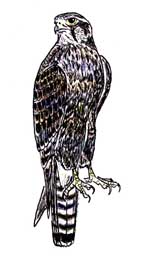
The disappearance of the Saker from some European countries has been linked with the steady decrease of unploughed steppe areas, which causes the disappearance of the Ground Squirrel - the main element of the Saker’s diet. The Saker also hunts birds such as the Starling, the Dove and the Lark, and occasionally preys even on the Hare, which it takes close to the ground. The species is widespread from southeastern Europe to Mongolia, south Baltic regions and northwestern Africa.
In the northern regions the Saker is migratory,
while in the south the species is settled.
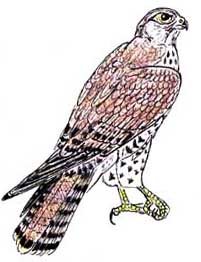
The male of saker
To Ukraine the birds return in late March to early April, although individual pairs winter in the southern regions. In Ukraine the birds nest across the whole territory save woodless steppes. For nesting, the Saker chooses predominantly forest gullies and meadows. Saker nests can often be seen along riverbanks or on tall alders in flooded marshland, among a nesting colony of herons. In mountainous regions the Saker prefers inaccessible cliffs. In forest massifs the Saker often resorts to occupational tactics, easily chasing the Raven, the Crow, the Buzzard, the Kite or the Heron from their nests, remaining for the entire nesting season in the colonies of above species or even in the immediate surroundings of other sakers. Most frequently, the Saker is seen to reside among Rook colonies. No marked antagonism has been observed between the Saker and rook species, this form of co-existence being evidently advantageous for the Saker. It is easy to see, after prolonged observation of the colony, just how difficult it is to pinpoint the exact location of a Saker nest surrounded by numerous Rook nests. Most amazing is that, when habitable nests are scarce, the Saker can even win a nest from a bird as formidable as the Imperial Eagle. As a rule, the Saker lays up to 5 eggs of a rather varying reddish colouring. The hatch is incubated, only by the female, for 30 days. There are rarely more than four hatchlings, which leave the nest 40-45 days after hatching.
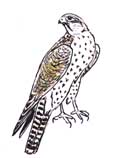
The young bird
According to R. Pfeffer in “The Bird on the Hand” (“
đÔÉĂÁ ÎÁ ŇŐËĹ”), Saker young taken from the nest at 10-14 days are easily cultivated. Kazakh falconers, according to an old tradition, keep a young bird in the house practically free, until it flies out to hunt by itself and returns with a full crop. From this onwards the bird is put on a leash and training begins – if this is not done, the bird, realising its independence, may fly off and never return.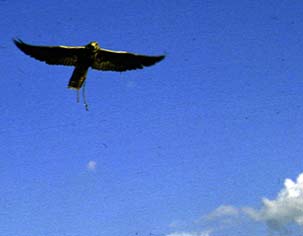
The Saker caught when adult and having its own hunting experience is often, for fruitful hunting, trained to be cast at a certain type of game. For this the Eastern peoples cast the bird at a stuffed specimen of the desired prey. Following a coherent system of training techniques it is possible to quickly teach the bird characteristic skills needed to achieve a desired result.
The Saker is greatly respected in the Arabian school of falconry.
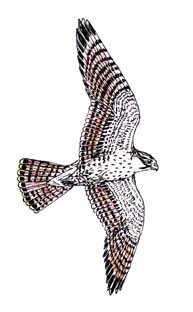
Due to its more spectacular hunting techniques, an exceptional Saker is often prized higher than the Peregrine or even the Gyrfalcon. It was noted by Geiling, describing the traits of the wild Saker in the Nile’s marshy delta, that “Its hunting is less hurried and impulsive than that of the other falcons. It can also be said that in the conditions in the Near East the Saker is more versatile and productive.”
Hunting with a well-trained Saker is considered an excellent past time for the more affluent in the Near East. It can be cast at practically the entire range of hunted game characteristic to the region, including the Hare, the Pheasant, the Great Bustard, the Partridge, the Chukar and various marsh waterfowl. This attitude to the Saker of Eastern falconers is further underlined by the fact that a century ago in the Middle Asia a well-trained bird could be purchased for a saddled camel.
As noted by a number of authors (N. A. Kholodkovskyj, A. A. Sylantiev and others), hunting the Gazelle is only possible with the Saker, as other falcons, through their impulsiveness, attack the prey with such force that they fracture their breastbone and die. In Turkmenistan the Saker is popular for hunting the Tolai Hare. In Ukraine the usually greater weight of the Hare must be taken into account when hunting, even with well-trained, large Saker females.
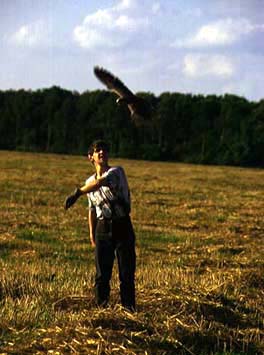
Some ancient writings present doubtful accounts of the Saker being cast at people. Although it is hard to agree with or to imagine this, Saker attacks at dogs are a relatively frequent phenomenon. Unfortunately, versatility and productiveness made the Saker the primary target for falconers around the world. A rough estimation is that up to 2000 young birds find themselves in captivity each year.
Several cases of illegal export of the Saker from China and the Russian Federation were reported in the international media. In such instances, a large number of the birds are often found dead by the customs officers. This is due to the fact that large parties of up to 40 specimens are placed, securely bound, in tight containers lacking proper ventilation and easily susceptible to a drop in temperature. Illegal trade of hunting birds severely undermines population numbers and therefore may lead, in the near future, to irreversible consequences.
The Saker is registered as an Endangered Species in many countries. This led to the active use of the Mexican Saker (Falco mexicanus) by many European falconers, as the bird can be purchased relatively cheaply in countries where its population is not currently under threat.
Although the Mexican Saker was never before used by falconers, practice showed that the species of American origin possesses superb hunting qualities and is easily trained. As well as that, the last decade was marked by positive changes – in the countries of Western Europe falconers have succeeded in breeding the Saker in captivity.
In Ukraine, the first steps towards restoring population numbers have also been made – according to V. Piliuha, in 1994 an experiment in releasing into the wild of Saker young reared in a breeding centre of Odessa Zoo was crowned with success. The hatchlings from the centre were placed into wild Saker nests with one or two chicks. Observations confirmed that all the young were accepted by their new parents and reared successfully, fledging at the same time as their wild siblings. The project was realised under the aegis of Ukraine’s Ministry of Ecological Security as part of the program to restore falling population numbers of the Saker undertaken by the Odessa Zoo from 1989.
Hatchlings reared by inexperienced falconers often have a marked unsuitability for hunting purposes. They cry out incessantly, disturbing the game, and are not easily trained. This can be gradually corrected by a new owner, having patience and sufficient experience. The main method of doing this lies in enforcing a strictly calculated timetable that includes continuous daily training and hunting sessions. In these conditions feeding is restricted solely to the training process and reward of successful casts at hunting.
Investigations of falconer researchers into crossbreeding the Saker with other falcons are well known. They are conducted with the commercial aim that would exclude further breeding of such birds and therefore create a competitive market for the owners of breeding pairs. The pragmatism of this situation has, apart from commercial profit, the advantage that allows taking up of falconry by amateurs without entailing removal of wild specimens from their habitat. This approach to artificial selection of hunting birds allows to lower significantly their market price, thus reducing the unnecessary agiotage surrounding falconry.
©
Ukrainian magazine "Naturalist"